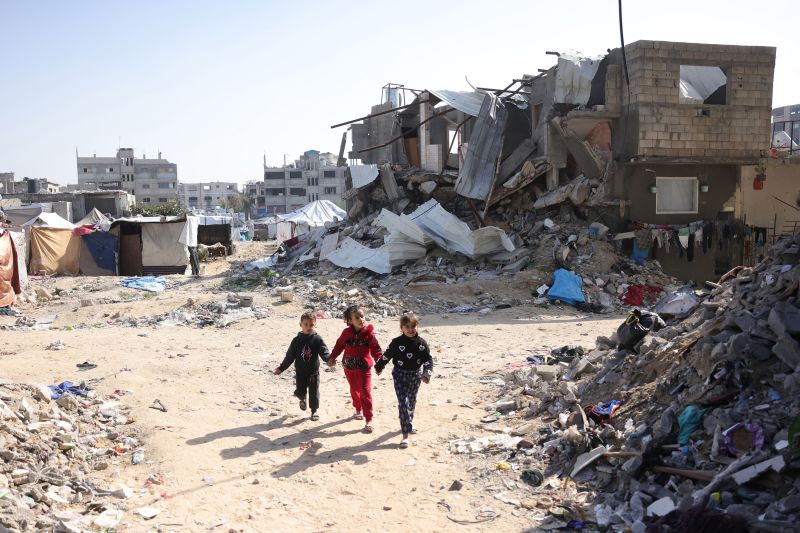One month ago, Israelis and Palestinians felt that rarest of things: optimism.
After months of stalled talks, there was finally a ceasefire in Gaza. There seemed to be a real path towards the end of the war.
But the situation has changed drastically since then.
The 42-day truce between Israel and Hamas is set to expire this weekend unless an agreement is struck to extend it. The two sides were meant to begin talks on a permanent end to the war in early February; three weeks later, they still haven’t started.
Since the deal was struck, there’s been a vibe shift in Israel. Prime Minister Benjamin Netanyahu is buoyed by the return of US President Donald Trump and under pressure from far-right members of his own cabinet to return to war. The Gaza ceasefire looks increasingly like it may end up being a fleeting interlude.
“We are ready to return to intense combat at any moment,” Israeli Prime Minister Benjamin Netanyahu told graduating military officers on Sunday. “The operational plans are ready.”
Netanyahu made his tenuous commitment to the ceasefire clear when he traveled to Washington DC to meet Trump earlier this month and opted not to send a negotiating team to Qatar or Egypt, which mediated the ceasefire.
He has replaced Israel’s security chiefs, who previously led ceasefire negotiations, with a close political ally – his minister of strategic affairs, Ron Dermer, who is said to be close to the Trump Administration. Israeli media last week was briefed by a “senior official” castigating the security chief-led negotiating team for giving Hamas too much in previous talks.
Even during the initial ceasefire negotiations it was clear that Netanyahu was skeptical of its potential second phase.
The first phase was always temporary for him. It was a way to get some hostages home without permanently ending the war or having to talk about what Gaza will look like once it’s over. Nearly 17 months since October 7, he has yet to present his vision for Gaza’s future, except to say that neither Hamas nor the West Bank-based Palestinian Authority should govern.
The second phase was always going to be trickier. It would see Hamas and Israel agree to a permanent end to hostilities, the release of all living Israeli hostages held in Gaza in exchange for Palestinian prisoners, and the full withdrawal of Israeli troops from Gaza, including from the Gaza-Egypt border.
Netanyahu is under tremendous pressure to return to war. His finance minister, the far-right-winger Bezalel Smotrich, has threatened to withdraw from the governing coalition if Israel doesn’t restart the war after this weekend. Itamar Ben Gvir quit his post as national security minister over the ceasefire.
It is unclear whether Hamas, for whom the hostages are their most valuable asset, would continue releasing Israelis without an Israeli commitment to end the war.
Though Trump championed and took credit for the ceasefire, his messaging since taking office has hardly been that of a peacemaker. He’s proposed expelling Palestinians from Gaza, he’s considering some Israelis’ desire to annex the West Bank, and he’s expressed doubt about the fate of the ceasefire. “I can’t tell you whether or not the cease fire will hold,” he said earlier this month. “We are going to see whether or not it holds.”
Steve Witkoff, the US special envoy to the Middle East, is returning to the region this week to try to save the ceasefire. He hardly expressed optimism when he spoke with the president’s son-in-law, Jared Kushner, at a Saudi investment conference in Miami last week. “Phase two is more difficult,” Witkoff said. “But I think ultimately if we work hard that there’s a real chance of success.”
Hours after Hamas released six Israeli hostages this weekend, Israel’s cabinet said it wasn’t going to uphold its end of the exchange – the release of 620 Palestinian prisoners and detainees.
The Israeli government and many international observers have expressed horror at the Hamas’ propaganda ceremonies staged to hand hostages to the Red Cross. It appears two incidents last week – the initial failure to hand over Shiri Bibas’ body and the staging of dead Israelis’ coffins under the banner of a bloodsucking Netanyahu – were a step too far. Hamas would have to stop “the humiliating ceremonies,” the prime minister’s office said.
Hamas spokesperson Abdul Latif Al-Qanou called Israel’s decision not to release the prisoners a “blatant violation” of the ceasefire agreement.
Critics of the Israeli government point out that Israel, too, has staged propaganda campaigns. Palestinian detainees released by Israel – some of whom have committed serious crimes, but most of whom were held without charge – have been made to wear sweatshirts upon their release with a Star of David and the Arabic phrase: “We don’t forget or forgive.” Others have said that they were made to watch hours of Israeli propaganda videos ahead of their release.
The future of the ceasefire now seems to come down to a simple calculation. Will Hamas see enough value in a short-lived peace to continue releasing hostages without long-term commitments from Israel? And if not, will the American government pressure Israel into the concessions necessary for a second phase?
Two million Palestinians struggling to survive depend on the answer. So too do the 63 hostages who remain in Gaza – just under half of whom are thought to be alive.
“Please, I just want to go home,” Evyatar David, who was kidnapped from the Nova music festival, said Saturday in a Hamas propaganda video as he watched hostages handed to the Red Cross. Though he was likely speaking under duress, David’s family authorized the video’s release.
“The time has come to end it,” he said. “You started something, finish it. Please.”
Eugenia Yosef and Kevin Liptak contributed to this report.
